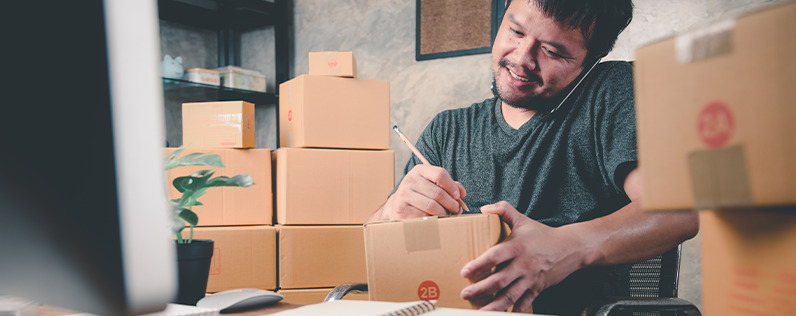
For many business owners, the challenging early years of the pandemic were a lesson in patience, agility, and innovation. You’ve likely learned how to address health and safety standards to protect your customers and your employees with methods you’d never had to consider before.
You’ve also probably learned what it’s like to rework your budget, marketing plan, and perhaps even your business model.
Here’s the thing: the lessons aren’t over.
Buying behaviors have changed dramatically, and experts predict that customers aren’t going to return to the old way of making purchases. In the future, the retail industry will see an even greater shift toward online selling, improved in-store technology, and demands by customers for greater personalization and connection.
Here is a closer look at the new retail best practices to follow so that your business can thrive, now and in the future.
Get all the tools you need to quickly find new customers and grow your retail store’s sales.
1. Sell Online
If you aren’t selling online already, it’s time to start. Modern consumers are shopping online like never before. In the second quarter of 2020, ecommerce sales added up to $212 billion — or 16% of total retail sales.
That might not seem like a large percentage until you consider that car dealerships, gas stations, and grocery stores don’t typically engage in online sales. For clothing, footwear, sports gear, and household items, online is a requirement.
Online stores can be set up easily with Constant Contact’s ecommerce tools, which can be connected directly to social media and email marketing campaigns.
But simply having a website isn’t enough. Many customers will be shopping with their mobile devices, so you’ll need to make sure your website is mobile-responsive.
It’s also important to monitor your online presence. Make sure your site operates smoothly and is an extension of your brand. Don’t forget to verify that your company’s address, website, and contact information are listed accurately on online directories like Google My Business and Yelp.
When your customers leave reviews, respond to each one as promptly as possible. If you receive any negative reviews, use the opportunity to address the situation in a friendly, open tone. Future customers want to see that you care about them and will resolve any issues they might have.
2. Upgrade In-Store Tech
Successful businesses are also integrating technology into their brick-and-mortar stores. Updating old-fashioned cash registers with tablets can create opportunities to impress your customers and improve their in-store experience.
Consider equipping employees with internet-ready smart devices that can help them answer questions about inventory and discounts. New tech also makes it easier to accept the most up-to-date forms of payment, such as touch-free credit cards.
Adjusting to new retail technology can feel overwhelming, but it’s essential if you want to keep up in 2021. Investing in upgrades can result in reduced operating costs and increased revenue.
3. Personalize the Customer Connection
Another benefit of following ecommerce best practices and upgrading your in-store tech is the ability to collect and use customer data to personalize the shopping experience. You’ll be able to track their purchases, size preferences, style interests, and shopping habits — all important information for increasing sales.
Take the data you collect about your customers to provide specific recommendations just for them through email campaigns. For example, you can tailor your messaging to not only fit their geographic location but also what they’ve purchased previously. The more you segment your email campaigns, the more valued and engaged your customers will feel.
Customer connection also benefits from supported and well-trained employees. In 2021, spend time motivating your employees with incentives for those who make customers feel valued. Setting expectations and rewarding members of your team who exceed them will help you execute the strategy.
4. Digitize Your Loyalty Program
Another way to make customers feel special is to invite them to join an exclusive loyalty program.
Text and email notifications are a great way to alert loyalty program members of exclusive new sales and discounts. Be creative as you revamp your loyalty program in 2021. Consider adding a VIP tier for even greater rewards. Some stores are exploring premium programs that charge customers a small fee in exchange for a regular discount.
Whatever your loyalty plan, think of it as a key part of a customer relationship that can last for years. When you’re not sure what will resonate, ask. Online surveys of your best customers can provide new insights you may not have considered.
5. Get Social
Shopping on social media has also gained significant traction in 2020. 37% of U.S. internet users between the ages of 18 and 34 have purchased something through social media. For adults older than 55, 11% reported buying through social media. That percentage is only going to grow.
It’s easier than ever to leverage your store’s social media presence to make more sales. New, in-app shopping opportunities mean purchases are just a swipe away.
Multichannel retail, which is simply selling your products on more than one platform, is one of the biggest trends of 2021. The more places your store can be seen, the greater your brand recognition. You’ll be able to diversify your market and reach new customers.
Plus, social media provides marketing opportunities that are cost-effective and easy to customize for your target demographic.
Thrive
Retail store owners who have weathered the coronavirus pandemic should be proud of what they’ve accomplished, but that doesn’t mean it’s time to rest.
Plan your strategy by creating or improving your online presence with a customer-friendly online shopping experience through your website.
Upgrade your in-store tech with new tools, while making customer connection a priority with personalized marketing and better loyalty programs. Expanding into social media will empower you to increase your reach with multichannel retail.
Today’s consumers expect their favorite brands to use technology in new ways. Modernizing your approach can help you navigate future challenges and strengthen your business.




